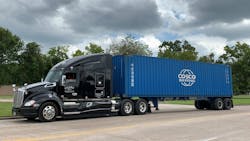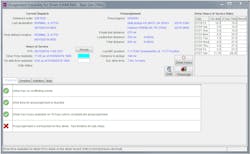President and co-owner of Houston-based Clark Freight Lines Danny R. Schnautz refuses to put “junk” in front of his drivers. As a former professional truck driver, Schnautz can spot junk when he sees it.
Over the years, that driver-focused mentality has made Clark Freight Lines particularly selective about the transportation management systems (TMS) and software that its professional drivers are asked to use.
The for-hire carrier runs a fleet of flatbeds, vans, specialized trailers, and a continuously expanding collection of intermodal chassis. The company hauls petrochemical products as well as imported lumber, plywood, stone, and other specialty cargo like warehouse materials, large statues, and even Grand Prix cars at one point.
See also: How to unlock fleet uptime with data-powered tools
Running that fleet is a mix of company drivers and owner-operators, many of whom have been with Clark Freight Lines for more than 20 years. Co-owners Schnautz and his brother—also a former truck driver—have found that automating certain aspects of the business, like safety training, dispatch, and payment settlements, have been a major timesaver for drivers. Schnautz is quick to point out, however, that regardless of advancements in technology, the business won’t work without that irreplaceable human touch.
“Drivers are people who have a name. Trucks are objects; they have numbers,” Schnautz told FleetOwner. “That’s a big difference for us. Technology aids us; it doesn’t replace us. Drivers are not interchangeable, and neither is our office staff. Using technology to complement their strengths and compensate for human weaknesses is the best place for the technology.”To assist dispatchers and drivers, Clark Freight Lines, which has a TMS app of its own under development, uses LoadMaster from McLeod Software to help dispatchers plan loads and provide input for driver miles in real time.
Operational information is entered into the TMS so all departments within the company know where drivers and loads are at any given time.
“We have an obligation to the drivers to deliver the best of what’s available—whether it’s the best run, the best days off, the best equipment, the best maintenance schedule, or the best trailer situation,” Schnautz said. “Whether a trailer is red-tagged or whether a run has increased in rate, we want to get that information in [the TMS] and share it with the driver.”
Clark Freight Lines also uses TMS to capture safety information from roadside inspections as well as anything related to drivers’ regulatory certifications and expirations—think hazmat or medical certifications and commercial driver’s license renewals.
The carrier, without a ton of effort or bandwidth, has been able to go through those driver records and give drivers plenty of notice when, for example, their hazmat certifications expire, according to Schnautz. Fleet managers also are leveraging these systems to help walk drivers through some of those certification processes as needed.
The business case for TMS
“I don’t think anybody ever buys a TMS because it’s cool,” noted Mark Cubine, VP of marketing for McLeod Software. “Fleets had a business outcome in mind that caused them to make the investment because it’s a lot of work to internalize a TMS.”
For Cubine, optimizing fleet management software comes down to a few value propositions. The first, he said, is improving a company’s operating ratio.
See also: Webinar: Increased visibility from middle to last mile
“There are all kinds of inefficiencies in every trucking company,” Cubine said. “Information and automation are the keys to unlocking all those efficiencies.”
Whether it’s fuel costs, network, or profitability in a lane, Cubine urged fleet managers to regularly question whether they are pricing freight correctly or leaving money on the table. Their most urgent responsibility, however, is making sure they are taking care of their drivers.
TMS software might assist fleets struggling with driver capacity, which is defined today by federally mandated hours-of-service regulations. Another value proposition of TMS is the ability to constantly manage that capacity, driver detention time, and conscientiously know how trucks are being utilized compared to how well the company and driver will be paid.
Automation can play a role in simplifying billing and settlements for all parties involved—drivers, back-office staff, fleet management, and shippers.
Fleet managers might also turn to a TMS solution if they find browsing various load boards cumbersome.
Axele TMS, for example, integrates with five load boards on its platform, including DAT and Truckstop.com, with plans to include more in the future, explained Shaman Ahuja, head of Axele. The company also offers TMS cloud software for truckload carriers and integrates with load boards, ELDs, market rates, maps, and accounting systems.
“Instead of having different Excel sheets to manage finances and driver assignments, fleets can do everything within the same application,” Ahuja said.
Certain TMS functionalities allow carriers to shop for a load, assign specific loads to a driver, and provide dispatchers who might be managing some 10 to 20 drivers at a time with real-time visibility of driver location and the status of the shipment. These days, that kind of visibility and planning is becoming increasingly important amid volatile fuel prices and an emphasis on further reducing deadhead miles.
Alto’s Express, a New Jersey-based for-hire carrier that runs refrigerated trailer loads for dedicated lanes in Pennsylvania, New Jersey, Delaware, and New York, has a base of company drivers, half of whom stay out all week with the other half of the company’s fleet home every day.
Alto’s Express dispatches to drivers daily and, before implementing fleet management software, that process was quite vexing. Dispatchers would verbally tell drivers their assignments and then follow up with a written manifest that included the customer’s location, pickup and delivery appointment numbers, and directions. Then, at the end of the week, drivers would submit paper copies of their proof of deliveries, bills of lading, fuel receipts, and lumper receipts. The carrier then would create invoices and send them out to their customers for remittance.
Alto’s Express has since streamlined its dispatch operations using Axele TMS. Now, fleet managers can set up existing customers with their addresses, rates, and contacts, so drivers can send them all the information they need to make their deliveries via an app on their phones.
Drivers now upload all their documents directly into the app, which then sends all required electronic paperwork to Alto’s dispatch team instantaneously.
“Having this ability has given us not only the resource to give our drivers the information they need, but in turn, we can then get the paperwork all together and then submit our invoices to the customers daily instead of weekly,” explained Chris Medina, a dispatcher for Alto's Express.
“Our drivers are getting all their dispatch information directly onto their phones,” Medina added. “This is a help to them because they have access to all the information that we are entering when we put their load in. Everything they need is right in the palm of their hands. Occasionally, a driver may need directions, and we can send them directly to their phones instead of them needing to pull over and call the office.”
A seat at the table for drivers
The job of a commercial truck driver is historically one of the most difficult professions out there. While other fleet employees can work from offices or even their homes, long-haul drivers endure extensive hours and face the risks of the road, all while being away from their families for long periods of time.
Manoj Parmar, product manager for Axele TMS, pointed out that because of these underlying conditions, there are fewer drivers than needed on the road today, and the industry has yet to grasp exactly how to utilize their time efficiently.
“They are wasting their miles, and they’re idle waiting for the next load,” Parmar told FleetOwner. “If they have the right technology to find the right load for them at the right time and the right location, then it will keep everything running.”
On top of that, many drivers aren’t met with even the basics of human respect and decency at customer facilities. That has been made all-too apparent over the course of the pandemic, and most recently Rep. Jason Silvis (R-Indiana) authorized legislation to require truck drivers access to restrooms when picking up or dropping off shipments.
House Bill 2465 creates the Truck Driver Restroom Access Act, which would require retail establishments, shippers, receivers, and terminal operators to give truck drivers access to indoor or portable toilets during regular business hours. Those who fail to provide access would be issued a written violation for a first offense and a $300 fine for each subsequent offense. The bill is in the House Transportation Committee awaiting review.
Parmar stressed that technology could help drivers not only with all the digitized paperwork they need but also by giving them the power to rate fleet customer facilities through TMS functionality.
“The facility will be rated and scored by the driver,” Parmar said. “We are trying to bring this aspect of how the pickup and drop-off locations treat drivers into our technology. It gives drivers a feeling of community together.”
For its own TMS app, Clark Freight Lines conducted a survey to determine what drivers wanted from the app. Schnautz told FleetOwner the app will include functions like settlements for owner-operators and payroll for company drivers. All drivers will have visibility as to when their check is coming out and how it is being billed for the week they are being paid. It would also contain customer location information, so the driver has it on hand as needed.The Clark Freight Lines app will also include a function so drivers can connect with one another and share information about certain facilities and places to park. Clark Freight Lines drivers also requested functionality for communications with all fleet departments as well as safety training and certification alerts.
“There are so many factors that go into the best match for a load and a driver, and when you add equipment and timing to that, you need the data to make the good decision, but for us, people make the best decisions,” Schnautz said.
“You have to adjust a lot in trucking,” he added. “When something changes—that could mean the customer cancels six loads, or there is a storm, or a truck breakdown, or a driver is sick—then you have to recover. The computer programs aid those decisions, but for us, it’s still the people making the decisions. If you don’t have all the information, it’s not going to be a good decision.”
Meeting driver expectations
The right fleet management technology should set up both the fleet and drivers for success, McLeod’s Cubine pointed out. Part of that success means keeping an eye on driver compensation over time and paying close attention to when drivers submit home-time requests.
“Drivers come with an expectation of where they are going to run, how you are going to handle their time off, and how much money they are going to make,” Cubine explained. “Yes, you must have the tools to evaluate how that driver is doing the work, are they on time, and are they doing everything I expect? But you have to ask, ‘Am I doing everything for that driver?’”
McLeod has a function in its TMS called Feasibility, in which planners can look at a load, hit the feasibility button, and calculate whether a driver can safely pick up and drop off the load in time.“Can they get there safely for the next load?” Cubine asked. “Can they physically do it without any question of forcing them to speed or being unreasonable about detention time?”
Kem Wallace, now a senior solutions architect at McLeod, started his career in trucking as a driver. He emphasized the importance of having drivers participate in the TMS coding process.
“We’ve also coded the system for driver preferences to be included for the fleet manager,” Wallace explained. “This allows managers to know this driver really loves going Northeast System or this driver doesn’t like a specific commodity. The system can recommend to the fleet manager what works, and that drives retention straight up. It doesn’t mean you can always do it, but now the driver feels you know them a little better.”
About the Author

Cristina Commendatore
Cristina Commendatore is a past FleetOwner editor-in-chief. She wrote for the publication from 2015 to 2023.



